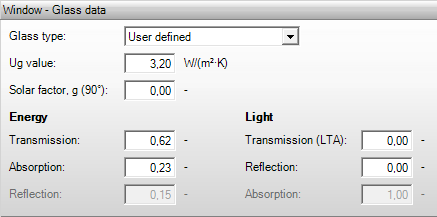

HL BS CL EPG
The different
glass types shown below are the most common in practice and they include
predefined glass data, such as Ug-value, solar factor, solar absorption,
transmission, light transmission, and light reflection in accordance with ISSO
8, Table 7. You may enter your own available glass data. Please make sure not to
set percentages, but rather factors, in Vabi Elements.
|
Type |
Ug |
g-factor |
Transmission (D) energy |
Absorption (ABS) energy |
Reflection (R) energy |
Transmission (D)LTA (τv) light |
Reflection (R) (ρv) light |
Absorption (ABS) Light |
|
Single Glass |
5,37 |
0,81 |
0,77 |
0,12 |
0,11 |
0,89 |
0,08 |
0,03 |
|
Attachments Window |
2,80 |
0,70 |
0,62 |
0,23 |
0,15 |
0,80 |
0,14 |
0,06 |
|
Double glazing |
3,20 |
0,70 |
0,62 |
0,23 |
0,15 |
0,80 |
0,14 |
0,06 |
|
HR glass |
2,00 |
0,66 |
0,57 |
0,25 |
0,18 |
0,80 |
0,12 |
0,08 |
|
HR + glass |
1,52 |
0,62 |
0,53 |
0,26 |
0,20 |
0,80 |
0,12 |
0,08 |
|
HR + + glass |
1,10 |
0,58 |
0,47 |
0,30 |
0,23 |
0,80 |
0,12 |
0,08 |
|
Triple glazing |
0,80 |
0,50 |
0,47 |
0,34 |
0,19 |
0,64 |
0,19 |
0,17 |
|
User defined |
|
|
|
|
|
|
|
|
|
ISSO Publicatie 32 (2011) bijlage D Uitgangspunten temperatuursimulatieberekeningen, fysische materiaalgegevens
| |
|
|
NEN 1068:2012 Bijlage E Warmtedoorgangscoëfficiënt van beglazing, zonder meerekening van randeffecten
|
[W / m². K] HL BS
CL EPG
The
Ug-value represents the thermal transmission of the glass. This is
the transmission of heat in Watt per unit of time and per m² at a temperature
difference of one Kelvin between inside and outside. This thermal property
should be measured in accordance with EN 673:2011, perpendicular to the surface.
Well-insulated glass is characterized by a low Ug-value.
[factor] CL BS EPG
The g-value (solar gain), is the
ratio between the incoming and the striking solar radiation. This is a property
of a glass system and a measurement of the total amount of solar energy
transmitted through the glass system. The value is between 0 and 1. The higher
the g-value, the more heat enters the room. This glass property must be measured
in accordance with NEN-EN 410: 2011, and is the solar heat gain in the event of
a vertical incidence.
|
|
Please note that the ZTA (Zontoetredingsfactor A) is in many cases different than the g value of glass. The ZTA was used in the Netherlands to indicate how much solar radiation can enter through the glass. Internationally, people do not use ZTA, but the g-value of glass.
1. ZTA, this value applies at an angle of 45°. 2. ggl;n, This value applies at an angle of 90°, so perpendicular to the glass. This value is specified by the European standard EN 410.
The ggl;n is always higher than the ZTA, because the sun entering perpendicular tot he glass gives less reflection. Vabi Elements Building simulation corrects the values for the whole year with the actual sun levels and the associated reflection.
The new Dutch calculation standards also no longer ask for the ZTA, but for the g-value (ggl;n). This makes the input of the glass data more in accordance with international standards and methodologies, and the glass data of the manufacturers can be entered better. |
CL BS
This is
the direct energy transmission [αe, TE%] and indicates the
percentage of energy that is transmitted through the glass. This is the part of
the directly transmitted solar energy, in other words the transmitted solar
radiation relative to the total striking solar radiation. The higher the
τe value, the more light is transmitted. This glass property must be
measured in accordance with NEN-EN 410: 2011
|
|
If the transmission [τe] is not known, but the absorption [αe] and energy reflection [αe] are, then the value of the transmission can be deduced from the following formula:
|
CL BS
Energy
absorption [αe, AE1%+AE2%] is the part
of the solar energy absorbed by the glass. This glass property must be measured
in accordance with NEN-EN 410: 2011. The higher the absorption, the more energy
is absorbed.
|
If the absorption [αe] is
not known, but the transmission [τe] and energy reflection [ρe] are, then
the value of the absorption can be deduced from the following formula: |
CL BS
Energy reflection is
the percentage of energy that is reflected by the glass. The higher the
reflection, the more energy is reflected.
CL BS
This is the light entry factor [τv, TL%] or light
transmission and gives the ratio between the incoming and the striking visible
solar radiation with a perpendicular angle of incidence. his coefficient is used
to determine the light in the room and is used to switch the lighting. The
higher the LTA value, the more visible light and heat enters. This glass
property must be measured in accordance with NEN-EN 410: 2011.
[factor] CL BS
The
visible reflection [ρv, RLe%], or light
reflection, indicates the percentage of visible light that is reflected by the
glass. The higher the reflection, the more light is reflected. This glass
property must be measured in accordance with NEN-EN 410: 2011.
|
Make sure that the light reflection [ρv] is different from the energy reflection [ρe] of glass. |
Light absorption is the part of the light absorbed by the glass. The higher the absorption, the more light is absorbed.